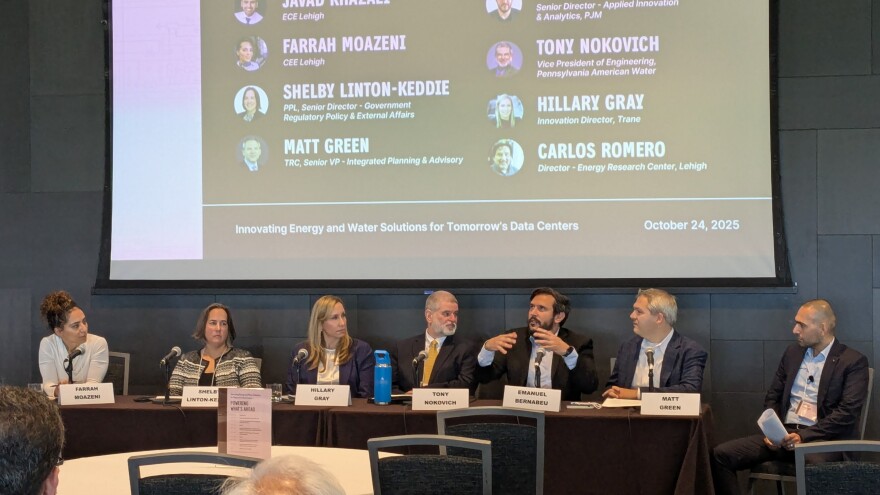LOWER SAUCON TWP., Pa. — As a surge of data center construction strains power and water infrastructure, experts met at Lehigh University’s Mountaintop Campus on Friday to prepare for a once-in-a-generation strain on — and potentially transformation of — these critical systems.
Before Friday’s guest speakers began their lectures and panel discussions, university Provost Nathan Urban took a moment to set the stage.
Urban referenced the Mountaintop Campus building where the symposium took place. Now Iacocca Hall, it was once the Homer Research Laboratories Complex, home to Bethlehem Steel’s most cutting-edge research and development projects.
The campus and the innovation it incubated were a powerful engine of last century’s economy, Urban said, while the buildings housing the beating heart of the next era of U.S. economic might well be data centers.
Supplying these new powerhouses will take difficult-to-comprehend amounts of water and electricity, plus careful management and thoughtful development.
Making it work could shape Pennsylvania’s economic outlook for decades to come.
“It's a complex puzzle, but one that I believe we can solve," Urban said. "The conversations we have today are about more than servers and algorithms and electricity generation.
"They are about shaping a sustainable and prosperous future for the commonwealth.”
And those data centers are hungry. Depending on how it is configured, a midsize data center can use as much power and water as a small city.
As developers and technology companies stand up new data centers to supply the computing power undergirding the explosion of artificial intelligence, power and water infrastructure are already under pressure, showing no signs of easing.
Power demands
One of the greatest challenges for the grid, panelists said, will be bringing on enough power generation to meet surging demand.
PJM Interconnection, the organization responsible for balancing energy supply and demand across 13 states including Pennsylvania, expects 32 gigawatts of new electricity demand across the network over the next five years.
About 30 gigawatts of that demand, PJM Senior Director of Applied Innovation and Analytics Emanuel Bernabeu said, comes from new data centers.
PPL Electric Utilities expects to more than triple its peak load over the next 10 years, from about 7.5 gigawatts to nearly 22 gigawatts.
By comparison, from 2007 to 2023, average electricity demand stayed flat as efficiency improvements roughly matched growth.
The U.S. electric grid is already struggling with enough generation capacity, leading to higher costs and more frequent emergency alerts declaring that all of the grid’s power plants are running at full capacity.
Companies that build and operate power plants selling electricity to the grid have not stepped in to fill the gap, several panelists said.
Building a new power plant is a slow and expensive process.
While it may only take a year and a half to two years to build a data center, a new power plant can take two to three times as long to bring online.
The queue for new power plants to join the PJM grid is full through 2030. Currently, the grid controller has signed off on projects adding about 50 gigawatts of generation capacity.
With no silver bullet to quickly add more power to the grid, officials responsible for managing electric infrastructure must look for ways to reduce or shift power consumption.
For example, different cooling technology may help reduce power consumption at the cost of greater water consumption.
Giant batteries can give data center operators a way to draw less power from the grid during periods of peak demand. If data centers plan ahead, they can shift non-essential work to parts of the day when they aren’t competing with, say, residential air conditioning for limited electricity.
To combat limited supply and get projects up and running faster, some data center operators opt to build their own generators, either to supplement a typical power connection or to replace it entirely.
Utility companies may not have the legal authority to force their customers to take power cuts or shift operations to times when electricity is less scarce. Instead, grid managers rely on market forces to influence behavior and keep the supply of electricity in line with demand.
When there is not enough energy to meet demand, power prices rise. As a result, electricity users try to shift or minimize use; power plants may adjust how many generators they have online.
Because the venture-capital-backed companies standing up these new data centers are so flush with cash, price-based incentives do not accomplish much, Bernabeu said, whether that's higher peak power prices or multi-million-dollar payments to secure a grid connection.
Instead, he said, these operators are more motivated by getting up and running as quickly as possible.
Utilities and grid operators will see more success building reliable energy infrastructure by working to connect customers faster if they take steps like coordinating onsite battery storage, contributing their own power generation or allowing power to be cut off in a supply crunch, Bernabeu said.
The same AI technology threatening to overwhelm the electric grid could also help protect it, as machine learning helps operators better predict demand, model the electric grid’s behavior and deal with heavy loads.
Water needs
Data centers can also strain water resources, as the facilities can use as much as three million gallons of water per day to cool its chips, said Tony Nokovich, vice president of engineering for Pennsylvania American Water.
Much of this water evaporates in the process, so large data centers must continuously replace water as it is lost.
However, a data center’s water use can vary widely depending on the temperature outside, dropping to as little as 800 gallons per day during the winter, Nokovich said.
Huge swings in water use can harm water quality, as customers draw too little water to keep pipes from stagnating, or draw too much and lower pressure in the system.
Speakers in Friday's symposium offered a similar prescription for addressing strain on water infrastructure: working with data center operators and developers to reduce water use, flatten out swings in demand, and reduce strain on infrastructure.
Pennsylvania’s water infrastructure faced a similar explosion of demand with the beginning of the shale fracking boom about a decade and a half ago.
The fracking process requires large amounts of water, typically in more remote areas with limited amounts available. Meeting that demand required the same sort of thinking water infrastructure managers will need to address data centers, like installing on-site storage tanks to spread out a driller’s water needs over time.
Above all, the symposium’s speakers said, officials and experts need to work across disciplines to figure out ways to stretch limited supply before prices surge beyond what residents can afford or there is not enough power to go around on the hottest summer days and coldest winter nights.


